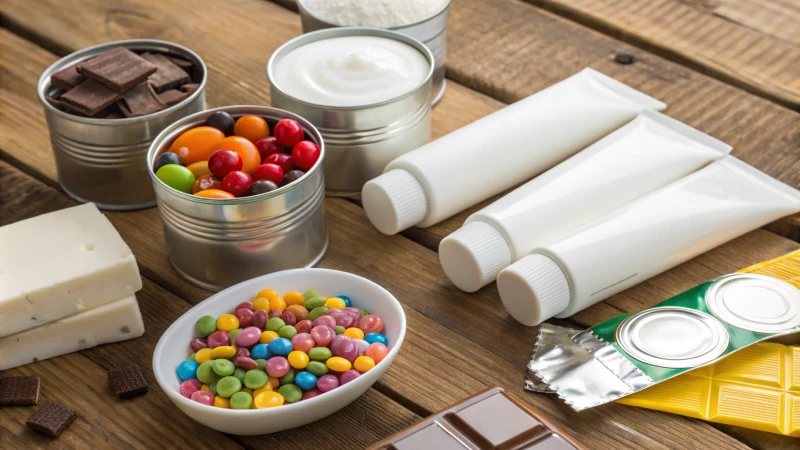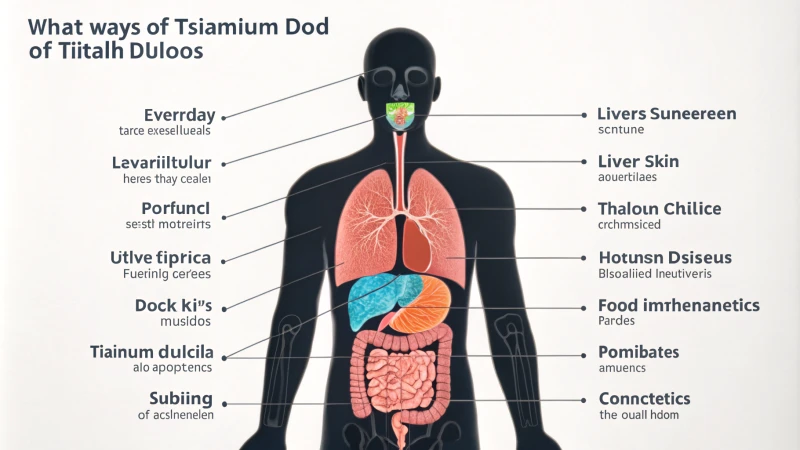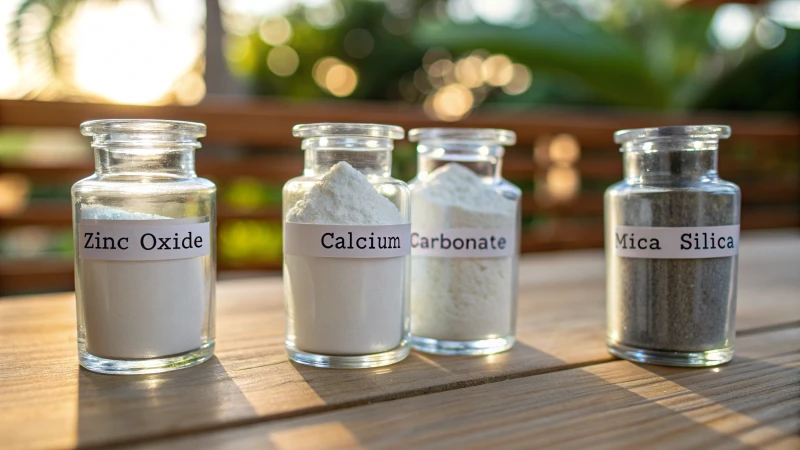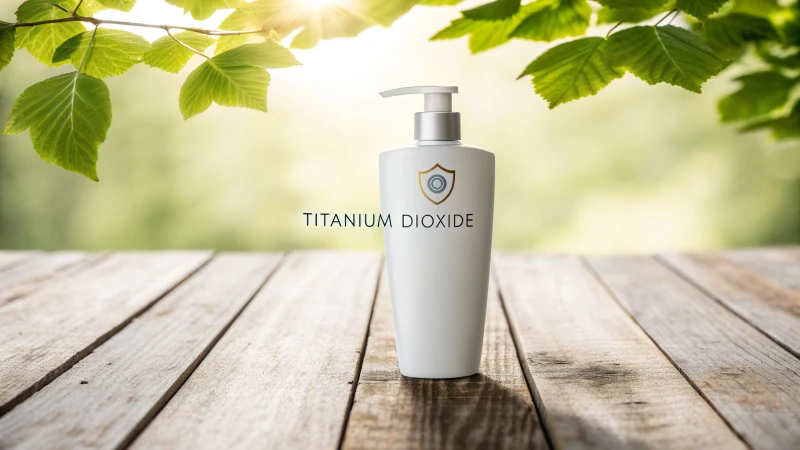
Titanium dioxide appears in many daily items. This includes sunscreen and toothpaste. People often wonder if it is safe.
Titanium dioxide is usually viewed as safe in its large form. However, people have concerns about the tiny particles’ harm. Problems arise mainly when people breathe in or swallow these nanoparticles in big quantities.
Titanium dioxide appears in many products today. People should know the possible risks of this compound. I once read an article that really surprised me. I began to notice how often I come across titanium dioxide. This happens whether I use sunscreen at the beach or paint during home repairs. Now, let us explore the latest research. Regulations have changed, too. Understanding these changes is important for everyone.
[claim claim=”Titanium dioxide is safe in bulk form for most uses.” istrue=”true” explanation=”Scientific consensus supports the safety of bulk titanium dioxide.”]
[claim claim=”Titanium dioxide nanoparticles are safe when inhaled.” istrue=”false” explanation=”Studies indicate potential respiratory risks from inhaled nanoparticles.”]
Why is Titanium Dioxide So Popular Across Different Industries?
Have you ever thought about why titanium dioxide appears in many products like your sunscreen and even in your snacks?
Titanium dioxide is a popular ingredient. It provides excellent UV protection. It brightens products with its bright white color. It also improves texture and stability. This ingredient appears in cosmetics, food and paints.

The Many Uses of Titanium Dioxide
Titanium dioxide has many uses that amazed me. It’s like a friend who excels in everything – from art to science. In material science, titanium dioxide works as a versatile pigment and UV filter1. Its high refractive index scatters light effectively, giving paints and coatings a bright, opaque finish. In cosmetics, it acts as sunblock, protecting our skin from harmful UV rays.
| Industry | Function |
|---|---|
| Cosmetics | UV filter, whitening |
| Food | Coloring agent (E171) |
| Paints | Opacity, brightness |
I became even more fascinated when I learned about its role in the food industry. This same substance that makes sunscreen effective also adds whiteness to products like candies and dairy. However, there is growing concern about its safety in food due to health issues.
Health Concerns and Regulatory Insights
Potential health risks of titanium dioxide, especially in nanoparticle form2, worried me. Studies suggest these small particles might bypass our body’s defenses, prompting serious safety questions. This issue drew the attention of European regulators, leading to a reevaluation of its use in food.
Regulatory Actions:
- European Food Safety Authority (EFSA): Recommended more studies on its safety in food.
- International Agency for Research on Cancer (IARC): Labeled it as a possible carcinogen when inhaled in large amounts.
Despite these worries, titanium dioxide remains safe for daily uses like paints or sunscreens if handled properly. Scientists continue researching its long-term effects.
Economic Impact and Industry Dependence
The coatings and paints industry3 relies heavily on titanium dioxide. It acts like a secret ingredient, offering excellent coverage and durability essential for sectors like construction and automotive.
| Property | Benefit |
|---|---|
| High opacity | Reduced application coats |
| UV stability | Longer-lasting products |
Though some may complain about costs, superior quality often justifies the price. As regulations change, businesses need to balance safety with performance—a challenging task.
[claim claim=”Titanium dioxide is a common food additive.” istrue=”true” explanation=”It is used as a coloring agent, known as E171, in foods.”]
[claim claim=”Titanium dioxide is classified as a carcinogen.” istrue=”true” explanation=”IARC classifies it as a possible carcinogen when inhaled in large amounts.”]
Why Is Titanium Dioxide Under Scrutiny Now?
Have you ever thought about why titanium dioxide is a hot topic these days? It’s very interesting.
Titanium dioxide is under examination. People are concerned about its nanoparticle form. These tiny particles might be harmful if breathed in or swallowed. Health risks could arise from this. Authorities are reviewing regulations because of these worries.

The Role of Titanium Dioxide in Everyday Products
My first clear memory of titanium dioxide’s impact was when I painted my kitchen. This ingredient gives paint its bright finish and helps reflect light beautifully. Titanium dioxide or TiO2, appears in many products, such as sunscreen as a UV blocker. It also works as a whitening agent4 in food.
Health Concerns and Regulatory Actions
However, recent studies show some problems with TiO2, especially in nanoparticle form. I read about these issues while learning about food safety after a health scare last year. In 2021, the European Commission changed its classification due to possible health risks when eaten. The European Food Safety Authority (EFSA) shared these concerns. I began rethinking the contents of my pantry.
Table: Regulatory Classifications of Titanium Dioxide
| Organization | Classification | Context |
|---|---|---|
| EFSA | Substance of Concern | Ingestion Risks |
| European Commission | Reclassified Substance | Potential Health Risks |
The Industrial Perspective
In my work within the industrial sector, TiO2 is crucial for paints and coatings. But safety involves more than just product ingredients. Non-nanoparticle TiO2 is generally safe. Yet, dust from industrial use can threaten respiratory health. This topic sparks lively debate at industry events I attend.
Ongoing Research and Developments
The safety of TiO2 remains uncertain. Researchers continue to study its long-term health effects. Regulations are likely to change as new evidence comes in. It is critical to stay up to date for those like me who work with industries that depend on TiO2. We regularly check material safety data sheets and review compliance with guidelines. This gives me peace of mind knowing that our practices are current. Understanding these changes helps in making wise choices about product safety and following global standards.
[claim claim=”Titanium dioxide is a possible carcinogen when inhaled.” istrue=”true” explanation=”The IARC classifies TiO2 as a possible carcinogen in industrial settings.”]
[claim claim=”Titanium dioxide is banned in all European food products.” istrue=”false” explanation=”It is classified as a concern, not banned, by EFSA for ingestion risks.”]
How Does Titanium Dioxide Affect the Body?
I remember my first encounter with titanium dioxide. It is a simple white powder that surprised me because it is a marvel in chemistry. But is it safe? Really?
Titanium dioxide’s effect on our bodies varies based on its form and exposure method. Regular titanium dioxide is generally safe. However, the nanoparticle type probably poses risks. These risks occur when we breathe it in or swallow it.

Titanium Dioxide Types and Uses
It’s fascinating to see how ordinary paint involves complex science. Titanium dioxide appears in two forms: nanoparticle and non-nanoparticle. The non-nanoparticle type works hard in paints and coatings. People often think it’s harmless unless inhaled in large amounts.
| Form | Common Use | Safety Concerns |
|---|---|---|
| Nanoparticle | Cosmetics, food | Ingestion and inhalation risks |
| Non-nanoparticle | Paints, coatings | Generally safe, but respiratory issues if inhaled |
Eating Risks of Titanium Dioxide
At a dinner, a friend questioned the "strange white stuff" in her toothpaste and cookies. This is titanium dioxide! However, the nanoparticle type, known as E171, raises concerns. It might accumulate in our bodies. This build-up could cause inflammation or more problems. The European Food Safety Authority (EFSA)5 is worried.
Breathing and Lung Problems
I have visited industrial sites where dust floats like snowflakes. Breathing these small particles daily can be dangerous. The International Agency for Research on Cancer (IARC)6 warns it may cause cancer if inhaled regularly.
Continued Study and Rules in Action
In Europe, they are looking at titanium dioxide in food again. People don’t want possible health risks in their meals. It’s wise to stay informed as research continues. Be aware of what we consume.
"Knowing both forms of titanium dioxide and their uses is vital for evaluating possible health dangers."
Knowing these facts is important. Titanium dioxide’s effects can help us make better decisions. Watch for new research and rules to choose safer options.
The insights here are valuable. They show how titanium dioxide affects us, guiding smarter choices in life. For further details, check out related articles:
Stay informed about recent changes concerning titanium dioxide and its effects on health concern everyone.
Footnote:
Research is ongoing. Scientists study how these particles interact with our bodies at a molecular level to find out the risks of different titanium dioxide forms used in industry and consumer goods.
[claim claim=”Titanium dioxide nanoparticles are safe for ingestion.” istrue=”false” explanation=”Studies suggest TiO₂ nanoparticles may accumulate and pose toxicity risks.”]
[claim claim=”Non-nanoparticle titanium dioxide is safe when inhaled.” istrue=”false” explanation=”Inhalation of non-nanoparticle TiO₂ can cause respiratory issues.”]
What Are the Alternatives to Titanium Dioxide?
I search through growing worries about the safety of titanium dioxide. I look for other options that won’t lower quality or harm health.
Zinc oxide, calcium carbonate, mica and silica serve as alternatives to titanium dioxide. Each substitute offers unique benefits. Zinc oxide provides protection from UV rays. Calcium carbonate helps with whitening. Mica and silica also serve well in many applications. These alternatives fit different needs. They are suitable choices for various purposes.

Exploring Zinc Oxide
I had a little journey with zinc oxide. It began when I researched sunscreens for my kids. I wanted them to be safe and effective. Zinc oxide became a promising alternative to titanium dioxide. It provides broad-spectrum UV protection10. Zinc oxide is considered safer due to its larger particle size, which reduces the risk of skin penetration. This is very important.
The Role of Calcium Carbonate
Calcium carbonate reminds me of my early days in the paint industry, where cost was the most important factor. This mineral serves as a fantastic whitening agent in food and paints due to its abundance and affordability. It’s like a budget-friendly car—it gets you where you need to go but lacks some features. It may not offer the same brightness or coverage as titanium dioxide, often requiring reformulation strategies.
Mica: A Natural Substitute
In cosmetics, mica adds a sparkling effect, bringing a special shine to products. As a mineral, mica has a solid safety profile; however, it may need help from additional compounds to match the opacity that titanium dioxide provides. It’s similar to needing extra seasoning for better flavor in a dish.
Utilizing Silica
Silica is interesting; I recall using it when texture mattered most. Silica is versatile and acts as a thickening agent or flow enhancer in many industries. In paints, silica’s light-scattering properties are useful as they can mimic those of titanium dioxide. However, using too much silica may change product texture11. Balancing its use is key—balance really matters here.
Comparative Table: Alternative Properties
| Alternative | Application | Benefits | Challenges |
|---|---|---|---|
| Zinc Oxide | Sunscreen | UV protection | Higher cost |
| Calcium Carbonate | Paint, Food | Cost-effective | Lower brightness |
| Mica | Cosmetics | Aesthetic shimmer | Requires formulation |
| Silica | Various | Versatility | Texture modification |
These alternatives offer flexibility to replace titanium dioxide while helping maintain quality. Just like recipe ingredients, each option requires careful consideration of their unique attributes and potential challenges for successful integration into existing formulations.
[claim claim=”Zinc oxide offers the same UV protection as titanium dioxide.” istrue=”true” explanation=”Zinc oxide provides broad-spectrum UV protection, similar to titanium dioxide.”]
[claim claim=”Calcium carbonate is costlier than titanium dioxide.” istrue=”false” explanation=”Calcium carbonate is abundant and low-cost, unlike titanium dioxide.”]
Conclusion
Titanium dioxide is widely used in various products, generally deemed safe in bulk form, but concerns arise over nanoparticle exposure, prompting regulatory scrutiny and ongoing research into its health effects.
-
Learn about titanium dioxide’s role as a UV filter and whitening agent in cosmetics. ↩
-
Explore studies on potential health risks of titanium dioxide nanoparticles. ↩
-
Understand how titanium dioxide contributes to opacity and durability in paints. ↩
-
Discover how titanium dioxide serves as a whitening agent in various products. ↩
-
Discover detailed findings from EFSA on the safety of titanium dioxide in food. ↩
-
Learn about ongoing research exploring the health effects of titanium dioxide. ↩
-
Understand the implications of nanoparticles in everyday consumer products. ↩
-
Stay informed about recent regulatory changes regarding E171 in the EU. ↩
-
Ensure workplace safety with guidelines for handling titanium dioxide exposure. ↩
-
Learn how zinc oxide protects against UV radiation and why it’s favored in skincare. ↩
-
Discover how silica impacts the texture and application of products. ↩





